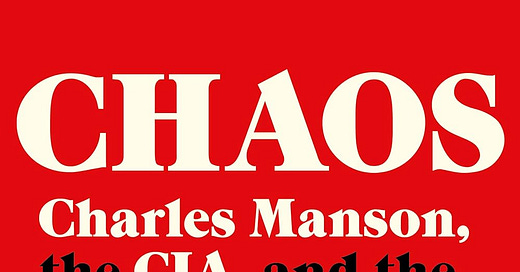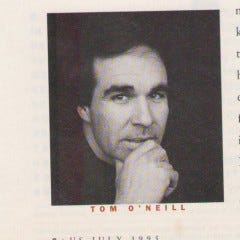For the next few Fridays, we’re going to be reading CHAOS - Charles Manson, The CIA, And The Secret History Of The Sixties by Tom O’Neill. There’s a Netflix series now based on the book, and I wanted to go deep into the book while watching the series, so why not do it with you guys.
Charles Manson?
In August 1969, there were two brutal sets of murders in Los Angeles, that shook the nation.
The most infamous attack occurred on August 8-9, when the actress Sharon Tate, wife of director Roman Polanski (yes, that guy) and four of her friends were murdered in her house.
The shocking aspects were
Sharon Tate was eight months pregnant.
She was a famous celebrity and wasn’t safe in her house.
The murders were so brutal. Sharon Tate was stabbed 16 times. Her friend Abigail Folger, heir to Folger Coffee, was stabbed 28 times. Another friend Wojciech Frykowski was stabbed 51 times and shot twice.
There was another similar brutal murder that happened the following night - Leno and Rosemary LaBianca in Los Feliz were stabbed similarly in their house.
Investigations revealed that the murders were orchestrated by Charles Manson, a career criminal and aspiring musician, who had a band of followers who called themselves the Manson Family. Manson believed these murders would spark a race war he called "Helter Skelter," inspired by his misinterpretation of The Beatles’ song.
After a highly sensational trial that gripped America and beyond, filled with drama about Hollywood, rock-n-roll, hippies, drugs, brainwashing, race wars and LSD, Manson and several followers were convicted and sentenced to life in prison.
While Charles Manson wasn’t the only famous serial killer of his era, the story of these killings has inspired a lot of media. Quentin Tarantino’s Once Upon A Time In Hollywood is the most recent. There’s also the series Aquarius, and Mindhunter has a chilling portrayal of Manson as well. The book Helter Skelter by Vincent Bugliosi, the chief prosecutor of the Manson case, is the most-selling true crime book, ever.
The Nosy Reporter Who Wouldn’t Stop Asking Questions
It’s 1999. This case is done and dusted, all the scary people are in prison, and all the good people got famous and rich from their involvement, everyone’s happy.
Enter Tom O’Neill.
Imagine what life was like in 1999 America. Computers are still a touch esoteric - everyone’s still worried about Y2K. Newspapers and magazines still exist in large numbers, and they want stories!
Tom O’Neill is at this point a freelance journalist who hadn’t worked in four months and substituting sleep for meals. But not because he isn’t good at what he does. In his own words:
I’d gotten in a shouting match with Tom Cruise about Scientology, Gary Shandling had somehow found a way to abandon me during an interview in his own home; and I’d pissed off Alec Baldwin, but who hasn’t?
When he gets a call from an editor at Premiere Magazine, to do a story on the 30th anniversary of the Manson murders, a kind of ‘where are they now’ of Hollywood people who had connections to the murders, he thinks it would be a boring story, because everyone’s already gone over everything. But he needs the money, and he says yes.
But very quickly, he finds things don’t add up.
The Most Riveting Prologue Ever
I love prologues. A good one is a teaser of what to expect in the tone and subject matter of the book, which takes the pressure off of chapter 1 to be arresting and intriguing while also introducing the characters and setting.
Tom O’Neill’s prologue is a masterclass in how to write prologues. The title is enough for most of us to pick up the book - it talks of Charles Manson, The CIA, and a ‘secret history’. But given the Manson murders are so picked-over and overanalyzed by cops and conspiracy theorists alike, it’s easy to dismiss this book as just another one of those.
But the prologue makes sure you know this book is nothing like that.
The prologue starts with him in a conversation with Vincent Bugliosi, the chief prosecutor in the Manson family trials.
“Nothing could be worse than accusing a prosecutor of doing what you’re implying I did in this case,” he barked at me. “It’s extremely, extremely defamatory”.
{….}
Bugliosi wanted to sue me. It would be, he soon warned, “a hundred-million-dollar libel lawsuit”. {…} If I refused to soft-pedal my reporting on him, I’d be powerless to stop it.
This is an LA cop. Not just any LA cop, but one with a reputation for being tough and aggressive. If he’s scared enough to threaten to sue, what on earth did Mr. O’Neill find?
Among many other things, I had evidence in Vince’s own handwriting that one of his lead witnesses had lied under oath.
This case was available to be picked over for 40 years at this point, and no one had found this? Yikes!
So Mr. O’Neill was trying to make Bugliosi trip up and admit to something. But Bugliosi stonewalled hard.
Plus, Bugliosi is an LA cop. Mr. O’Neill knows from other reporters that Bugliosi had threatened them with putting drugs in their kids’ school lockers. And Bugliosi has told him to his face that he didn’t mind hurting people to “exact justice or get revenge”.
Yikes.
This particular passage stood out to me:
I’m not a churchgoing person, but I’d gone to church that morning and said a little prayer. {…} I hoped that my interview with Vince would mark a turning point in my seven years of intensive reporting on the Manson murders. I’d interviewed more than a thousand people by then. My work had left me, at various points, broke, depressed, and terrified that I was becoming one of “those people”: an obsessive, a conspiracy theorist, a lunatic. I’d let friendships fall away. My family had worried about my sanity. Manson himself had harangued me from prison. I’d faced multiple threats on my life. I don’t consider myself credulous, but I’d discovered things I thought impossible about the Manson murders and California in the sixties - things that reek of duplicity and cover-up, implicating police departments up and down the state. Plus, the courts. Plus - though I have to take a deep breath before I let myself say it - the CIA.
Whoa whoa whoa.
There are always those movies about a reporter letting a case take over his life, but I never found them that believable. But here he is, driven to the point of madness and wondering if he is one of those weirdoes with a Geocities page saying Manson is actually an alien from Area 51.
But if Manson himself harangued him, it’s got to be legit.
But then he mentions the CIA? And he’s still around and not in prison?
Wait, what did the CIA have to do with this? Aren’t they only supposed to operate outside the US?
Tom O’Neill publishes the book in 2019, 20 years after he was first contracted to write the article. The magazine no longer exists. Vince Bugliosi is dead by then, and isn’t around to sue him. Charles Manson himself died at 83 years old in 2017.
He ends it thus:
Now, most of the people who had the full story, including Manson himself, have died, and the questions I had then have continued to consume me for almost twenty years.
But I’m certain of one thing : Much of what we accept as fact is fiction.
A few weeks ago, the newsletter of a writer I follow said something like “The hard facts that got me thrown out of multiple writing forums. Listen to my podcast for the unedited story”. It’s easy to claim that you have some shocking truth for attention, and many do.
Even if nothingis true, the bonafides of the author ensure it’ll at least be an entertaining, creative read.
But this seems like a legit op. In which case, I wondered, why wasn’t this receiving more mainstream coverage? Like, now there’s a Netflix series, but I only heard of this 3 years after the book released, on Joe Rogan’s podcast. Not a Good Morning America clip, not a special on 60 Minutes. When I looked on Youtube, there weren’t too many clips about the book from mainstream media.
Anything with Manson in the title gets clicks, so you imagine mainstream media would be all over this book. If this was all false and he was casting aspersions on people, why weren’t there people rushing to debunk him? If it were true, why wouldn’t they want to talk about it?
Why I’m Diving Into This Book
The one big thing I took away from this was you can work very hard on something and have it consume your life, and think the result would be a shoo-in for success, and… it might not be a success for years. Or at all. You’ve got to just love the game and keep at it for as long as it takes. That makes me feel solidarity for this author.
In any case, all of this got me hooked and I listened to the 16-hour long audiobook in one day, pausing only to ask my husband stuff like “How do your parents remember the Manson trials?” and “Did you know what your government was doing, with MK-ULTRA?”. [His answers were “They were ten when it happened” and “Yeah, a homeless guy told me.”]
What struck me about this story was how American it is. This is not a story that could have taken place any other time or place. Before I read this book, I had a vague idea that the serial killers of the ‘60s and ‘70s were just so prolific because of being able to get around in cars while the authorities didn’t have resources to track crime across jurisdictions. But this book gave me a different idea - The culture of the ‘50s and ‘60s was shaped by a government that was paranoid enough about the state of the world to be hostile to their own citizens, and the serial killers were a result of that paranoia and hostility.
Tom O’Neill is of this culture, so for him this is all like water to a fish, and he doesn’t talk about the larger cultural implications. But all I could think of was, this wouldn’t happen in India, not to this extent anyway. The cultural aspect of it grips me. What were the cultural causes of a government with multiple levels of secrecy that had cops, scientists, secret agents, and agents who were even more secret than that, all contriving to keep a serial killer free, on the streets, and killing some more? What has resulted from decades of doing this? Are they still doing it?
What makes it okay for a government to decide to experiment on its own citizens without their consent? What exactly is unique about the American government’s relationship with its people that such things happen? I can’t, for instance, imagine MI6 pulling something like this.
We will cover all this and more over the next few weeks.
Next week:
We’ll go into the Tate murder in some (non-grisly) detail. Tom O’Neill starts interviewing people for the story, and ends up finding connections to drugs and a hidden sex tape. Let’s see where that leads. Tune in, next Friday, same time, same email, same Substack.






Unethical human experiments are more common than you think https://en.wikipedia.org/wiki/Unethical_human_experimentation